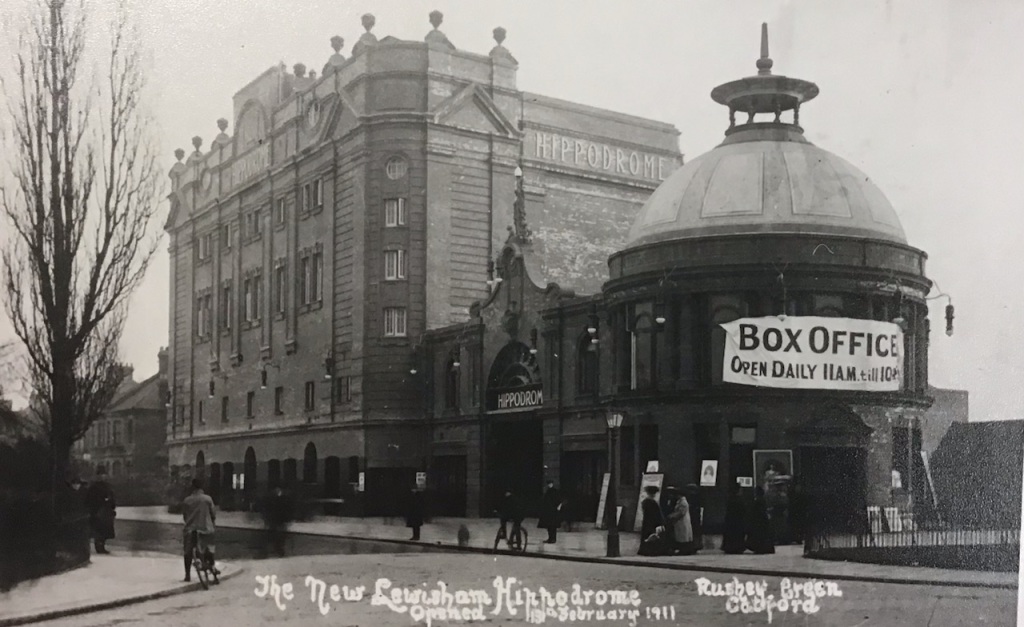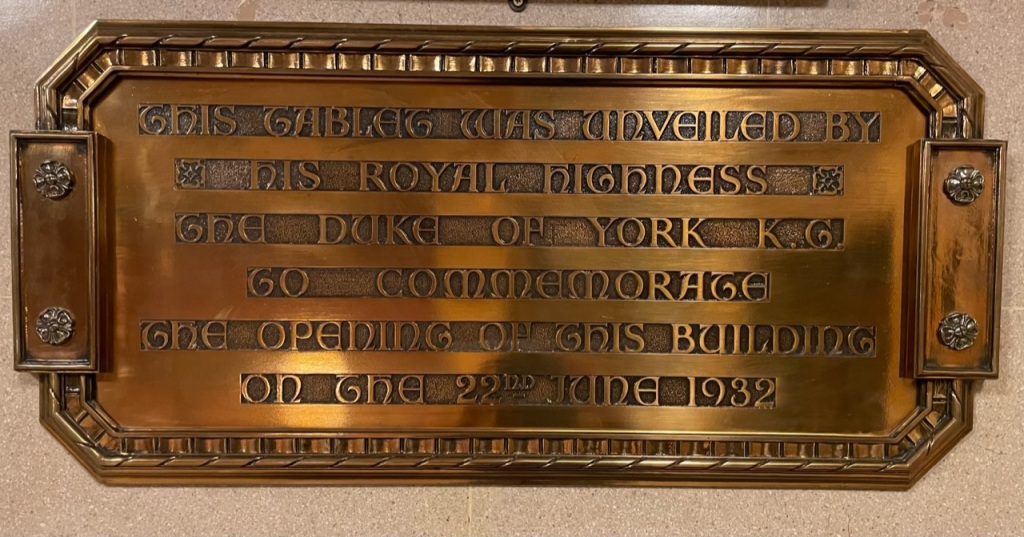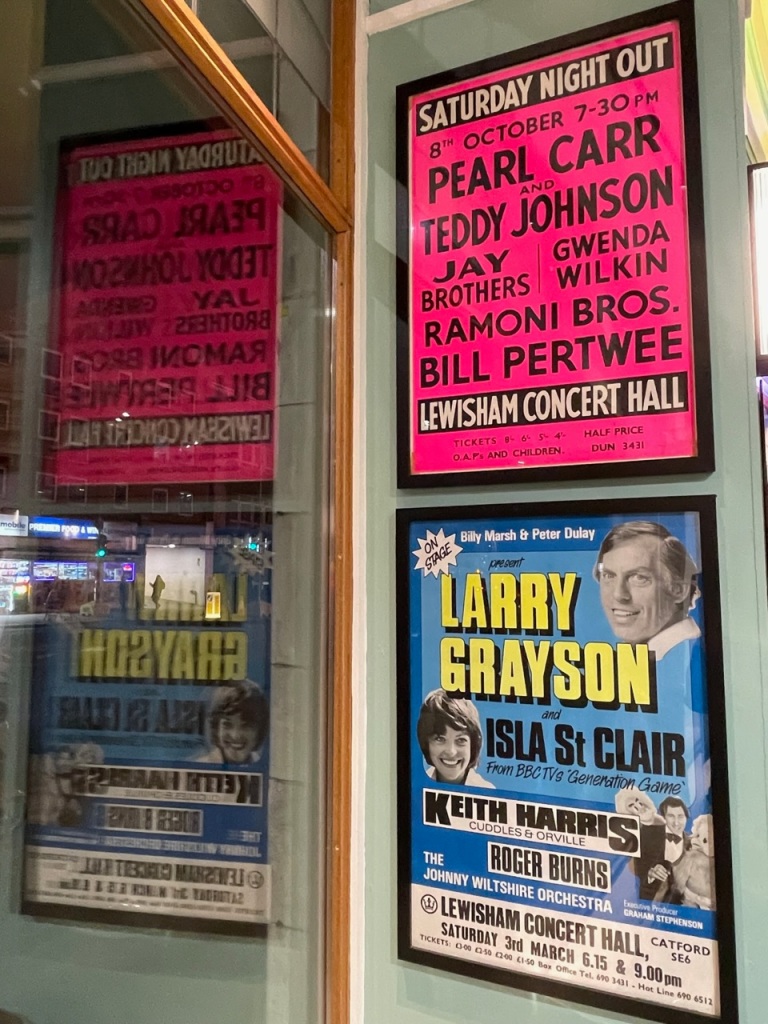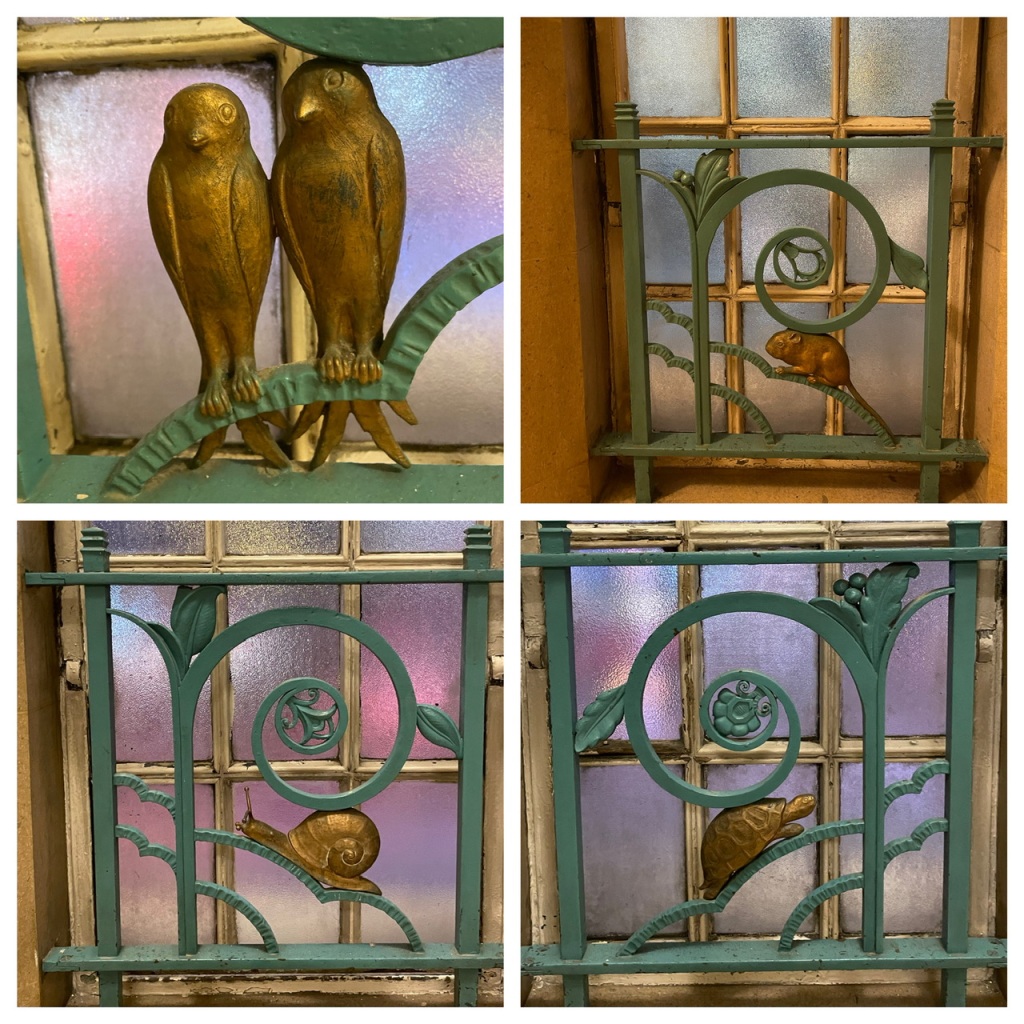What is currently known as the Broadway Theatre is arguably one of Lewisham’s finest 20th century buildings both inside and out. It dates from the early 1930s and used to be next to a gothic 1870s Town Hall – pictured together below.

When the Town Hall was first built there appear to have been lawns backing onto what was then called Springfield Park Crescent (now called Catford Broadway) . The Town Hall was gradually extended into the lawns around the turn of the 20th century. The rest of the curved site seems to be been enclosed for use as a council depot. At the eastern end of the Crescent, facing onto Rushey Green and the Black Horse and Harrow (now Ninth Life) was a fire station, presumably the small building behind the tram below.

After the fire station closed, the site’s owners, Lewisham Parochial Trustees, sold it to the Borough Council for around £1,300 in 1919. Originally, it was planned to build a war memorial there, but clearly plans changed, as that was built facing Lewisham Hospital (1).
Without a clear use identified, the site seems to have been used as something of a dump (2), so there will have been a degree of relief in Catford when in 1925 plans were announced for an alternative use for the site – the development of a new extension to the Town Hall, a concert hall and shops. An Act of Parliament was required for the development, part of a wider London County Council Bill, which presumably received Royal Assent in 1926. Part of the logic was the lack of a large hall, other than cinemas, in the old Borough of Lewisham (3).
The latter logic doesn’t really bear up to much scrutiny though, as almost opposite was the Hippodrome which was where Eros House has been since the 1960s. The 3222-seater Hippodrome had opened as a music hall in 1911, 14 years before the plans were developed.

The architects for the development were Bradshaw Gass and Hope of Bolton, who were selected after a competition which saw 71 entries (4). The Town Hall extension for the Borough of Lewisham was unusual for them in that most of their work was in the North-West. They are still based in Bolton but work such as this brought them to a much wider attention winning several other commissions to build town halls before World War 2.
The building work was put out to tender in 1930 and 27 bids were received, with G E Wallis and Sons one of £126,944 being successful (5). They were a firm with roots in Maidstone that had been in existence since 1860, although were central London based in Old Cavendish Street by that stage. The firm still exists as Wallis. Work was overseen by Alderman A Rennie who was Chair of the Town Hall Extension Committee (6), he was a longstanding councillor who was a member of the Municipal Reform Party (7) – the name the Conservative used in London local elections in that era.
The ‘Town Hall Extension’ was officially opened on 22 June, 1932 by the Duke of York, who became King George VI just over four years later.

Despite the Borough Council having built the Hall, it appears that they had no powers to organise or promote events in its early days, although this changed after World War 2. For the community and church groups, at least, there is a surviving register kept from April 1934 of those who had booked, the rooms used, whether this included the now listed organ. The first entry was for the London Advent Mission who booked the main hall between 6 and 10 on Sunday 1 April at a cost £10 10s which they had paid on the Friday before. There was an arrear brought forward of £4 14s from 1933/34 from Crystal Palace Speedway Supporters Motor Club.

The photograph below shows bookings from later that financial year in February 1935 – there were auctions, lectures, Lewisham Musical Association competitions, a boxing tournament and the Advent Mission were back, this time using the small hall. There were also orchestral concerts and weekly dances held.
During the war the theatre was put to very different uses, the auditorium floor being strengthened and converted into a public air raid shelter a telephone exchange, presumably linked to the ARP headquarters in the Town Hall basement next door, as well as being a ration book distribution centre.
The name changed to ‘Lewisham Concert Hall’ in 1965 and continued a post war tradition of variety – from the top poster, Pearl Carr and Teddy Johnson came second in the 1959 Eurovision Song Contest, Gwenda Wilkin was an ‘accordion virtuoso’, the Ramoni Brothers were acrobatic dancers’, and Bill Pertwee was probably appearing doing comedy, but became best known for his role as ARP Warden Hodges in ‘Dad’s Army.’ The Lewisham Concert Hall also hosted some well-known jazz performers, such as Dizzy Gillespie and Chick Corea along with Motown legends The Four Tops and Gladys Knight.
There was a lot of comedy there in the 1980s and 1990s – with Alan Davies, Paul Merton and Eddie Izzard all appearing, along with several plays, including Catford Upon Avon Shakespeare Festivals in 2016 and 2017. It probably isn’t the best venue for staging plays though as the backstage area is tiny.
Despite the lack of space, most years the theatre has a pantomime – oh not they didn’t ….. oh, yes they did! One of the corridors behind the scenes has stunning photographs of many of the performances, some of which I vaguely remembered. You can book now for the 2023 pantomime (or could when the post was published in spring 2023).
The renaming to the Broadway was in 2002, 70 years after the opening by the Duke of York, by his daughter Queen Elizabeth II. There was a major refurbishment in which was completed in the spring of 2023 to allow better backstage access to enable it to meet concert promoters requirements along with making it much more accessible front of house.

Events are now beginning to be listed there, so do sign up for their mailing list and go and see performances there! When you do go, get there early, have a wander round, look out for some of the lovely details, like the glazing on the stairs above in the bar and the wrought iron work details on some other stairs (pictured below), and keep an eye open for posters and photographs of past performances – some real trips down memory lane are to be had!
Notes
- 23 July 1919 – Lewisham Borough News
- 07 May 1930 – Lewisham Borough News
- 30 December 1925 – Lewisham Borough News
- The Times June 23, 1932
- 11 April 1930 – Forest Hill & Sydenham Examiner
- Ibid
- South London Observer 14 April 1944
Credits
- The photographs of the theatre under construction, the Town Hall with the tram terminus and the Hippodrome are all part of the collections of Lewisham Archives, they are used with permission and remain their copyright
- The photo of the register and accounts is part of the collection of the theatre, it is used with permission and remains their copyright
- The night time picture is on a creative commons – source
- And finally, a massive thank you to Carmel O’Connor from the theatre for the behind the scenes tour and Rhoda Idoniboye from Lewisham Council for the invitation – it was an absolutely wonderful evening!








Hi Paul,
Yet another wonderful trip down memory lane for a long exiled Catford boy! Many thanks indeed.
Kindest regards,
Duncan Wilson ________________________________
Glad to be of assistance!
That was very interesting, I went to the concert hall when I first got interested in classical music , the Lewisham Phiharmonic ? I think, this was in the Sixties.
Very interesting article I was brought up in Hither Green and always loved this iconic building. I recall my granny taking me to pantomimes there in the 1950s and later going to pop concerts there and at the Gaumont in Lewisham. Wonderful memories.